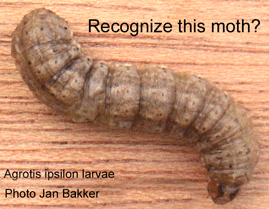Alien species sometimes damage native landscapes. In Voyage of the Beagle, in entry dated September 19, 1832, Darwin describes the spread of an introduced European thistle Cyanara cardunculus in Banda Oriental, now Uruguay: “very many (probably several hundred) square miles are covered by one mass of these prickly plants, and are impenetrable by man or beast. Over the undulating plains, where these great beds occur, nothing else can live…I doubt whether any case is on record, of an invasion on so grand a scale of one plant over the aborigines.”
 The challenge is to recognize invasive species before they become established. In 11 January 2008 Polar Biology researchers from Stellenbosch University and University of Western Ontario apply DNA barcoding to otherwise unrecognizable moth larvae on sub-Antarctic Marion Island. The indigenous Lepidoptera on Marion Island comprises 2 or 3 flightless moths, and the occassional adult winged moths or butterflies have been assumed to be transients arrived on fresh produce.
The challenge is to recognize invasive species before they become established. In 11 January 2008 Polar Biology researchers from Stellenbosch University and University of Western Ontario apply DNA barcoding to otherwise unrecognizable moth larvae on sub-Antarctic Marion Island. The indigenous Lepidoptera on Marion Island comprises 2 or 3 flightless moths, and the occassional adult winged moths or butterflies have been assumed to be transients arrived on fresh produce.
 In April 2004, 3 noctuid moth larvae were found in an abandoned Wandering Albatross nest, a common habitat for one of the indigenous moth species. The larvae could be tentatively identified only to genus level and so rearing was attempted, with one larva dying after several months of pupating (as an aside, this is one example of how morphologic identifications can be laborious and/or incomplete, even for experts). The final larva was killed and preserved for DNA study; COI DNA barcode region was amplified using standard Folmer primers. The Marion Island moth larva barcode clustered with the 40 or so Black Cutworm Agrotis ipsilon sequences in BOLD, and was distinct from COI sequences of the other 18 Agrotis species in BOLD. Agrotis ipsilon is a common pest that feeds on a wide variety of plants. The authors conclude that Agrotis ipsilon is an established alien species with the potential to disrupt local ecosystems and that “steps be taken to eradicate the species from Marion Island.”
In April 2004, 3 noctuid moth larvae were found in an abandoned Wandering Albatross nest, a common habitat for one of the indigenous moth species. The larvae could be tentatively identified only to genus level and so rearing was attempted, with one larva dying after several months of pupating (as an aside, this is one example of how morphologic identifications can be laborious and/or incomplete, even for experts). The final larva was killed and preserved for DNA study; COI DNA barcode region was amplified using standard Folmer primers. The Marion Island moth larva barcode clustered with the 40 or so Black Cutworm Agrotis ipsilon sequences in BOLD, and was distinct from COI sequences of the other 18 Agrotis species in BOLD. Agrotis ipsilon is a common pest that feeds on a wide variety of plants. The authors conclude that Agrotis ipsilon is an established alien species with the potential to disrupt local ecosystems and that “steps be taken to eradicate the species from Marion Island.”
It is easy to predict that rapid identification of potential invasive alien species will be a major application of DNA barcoding, with direct economic and ecosystem benefits.